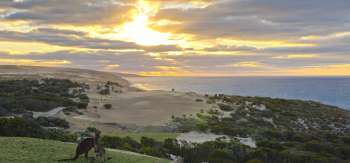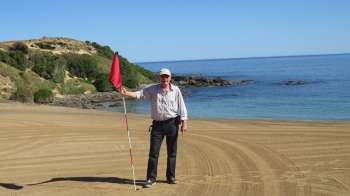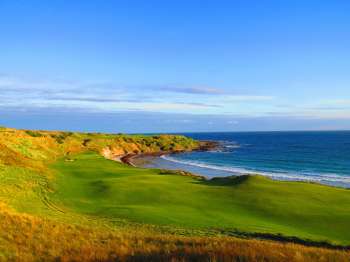Legend or a marketing myth?
It was described by one leading golf course architect as a mongrel grass, and by a superintendent as, ‘the couch you have when you’re not having a couch’. It’s routinely dismissed by critics for its poor quality and poor playing characteristics, yet over a relatively short period of time Legend has established itself in southeast Australia as one of our most popular golf course grasses.
Given what we now know, it seems that the success of Legend was more due to its superior marketing, rather than any superior maintenance profile. The story of how this unusual grass established a foothold in the Australian golf industry is certainly an interesting one.
The turfgrass industry in Australia is small and constantly evolving. Things move in cycles, and trends established with the best of intentions can end up being roundly condemned a few short years later. To understand the divisive nature of Legend it’s important to look back at the couch debate of the mid-to-late 1990s, when some curious criticisms were being made of popular hybrid varieties like Santa Ana and Wintergreen.
Back then many in the business, including prominent course architects and superintendents, were suggesting that the surface these grasses presented to golfers was too perfect. The argument was that the ball ran too far on pure couch, and that the lies were too predictable. On undulating courses there was the additional problem of balls pooling in collection areas during the winter months and these areas being filled with divots. When Legend arrived in the late 1990s the industry was clearly on the lookout for something new.
That something was marketed as a cure-all couch with a broader leaf that would slow the golf ball down, establish itself quickly and apparently require less ongoing maintenance. The grass was endorsed by industry bodies like the Victorian Golf Association and the Australian Golf Course Superintendents’ Association, who both recommended Legend after conducting turfgrass trials in Victoria and New South Wales.
The VGA’s report identified Legend as the ideal couch for low input environments, despite Santa Ana receiving a higher quality score on most of the trial plots and a comparable dormancy and drought tolerance performance. Santa Ana was also available at next to no cost, whereas Legend, an unpatented strain of common couch, had to be purchased through just one supplier, and was expensive.
Regardless, it was the high thatching tendency of the hybrid couch strains that led the VGA to recommend Legend as a preferred turfgrass for Victorian fairways. The VGA also made the rather puzzling claim that while low handicap players may appreciate the tight surface that Wintergreen and Santa Ana provides, poorer golfers with inconsistent swings may agitate for higher mowing heights which better suits Legend’s broader leaf and prostrate stolon growth. In essence the VGA were labeling tight lies as undesirable and, by extension, the top links courses of the UK as no place for the average weekend warrior.
Despite what some might describe as dubious credentials, Legend did well in its early years in Victoria by attracting fairway clients like Commonwealth, The National (Ocean), Moonah Links, Ranfurlie, Peninsula, Settlers Run, Sandhurst and St Andrews Beach. Royal Melbourne later chose Legend for its fairways as well, as did a number of metropolitan courses and smaller country clubs interstate.
Andrew Purchase, a director of the Turnpoint Group, describes the late 1990s and early 2000s as a period when people in the business were looking for a point of difference to Santa Ana and Wintergreen. His company maintains golf courses across Australia, and he says that while Legend was, ‘planted with gay abandon during that period, it has become clear that we didn’t realize until half a dozen years down the track what we were getting with Legend and how we should be managing it.’
Purchase’s problem with the grass is that it tends to creep into the greens and is more disease prone than a hybrid couch, especially on the Mornington Peninsula. At St Andrews Beach, one of the courses Turnpoint maintains, the cost of buying the fungicide needed to prevent disease in the fairways has been substantial.
Purchase says Legend also loses purity over time, something The National’s Leigh Yanner acknowledged was a problem for him on the club’s Ocean Course. Because it is an impure common couch, over time the finer blades tend to dominate the grass and you end up with a patchwork of various couch strains. According to Purchase, the idea that Legend requires less maintenance than Santa Ana ‘is a myth.’
Another critic of Legend is Graeme Grant, a former superintendent at Kingston Heath and one of the men credited with introducing pure couch fairways to the Melbourne Sandbelt in the 1980s. Grant learnt his trade under legendary Royal Melbourne super Claude Crockford, and spent 16 years at The Heath cultivating some of the finest couch fairways in the world.
Grant began at the club shortly before it hosted the 1983 Australian Open, a time when pure couch fairways were unheard of in Victoria. As soon as that tournament ended, he recalls, ‘we started spraying our fairways to eliminate all the cool season grasses and broad-leafed weeds.’ During the process Grant trialed, amongst others, a fine hybrid couch, known as Santa Ana. Developed in America to suit the climactic conditions of southern Australia, the grass was able to perform in areas that had previously struggled. Together with his good friend John Spencer at Huntingdale, Grant helped popularise the use of year round pure couch surfaces on Victorian fairways, and in particular the use of Santa Ana.
For Grant the concept of Victorian clubs shifting from successful hybrid couch strains back to a less predictable common couch is difficult to comprehend. Not only does he believe that Santa Ana provides a far better surface than Legend, he says it is easier to maintain. He also disputes the notion that Santa Ana’s higher thatch levels are undesirable, pointing out that thatch (turf density) is essential for a good winter cover and that good turf management is all about observing the turf and planning according to the conditions. Some of his clients only scarify their fairways every third year and Grants says that, ‘other maintenance factors such as irrigation, fertiliser levels and mowing heights and frequency can be adjusted to control thatch levels.’
Yanner agrees that Santa Ana and Wintergreen provide a better playing surface than Legend, and that the grasses can be managed to suit the conditions in play at the time. He says the philosophy with Santa Ana was always, ‘to keep it short and cut it often, so balls would run forever and the lies were always really tight.’ On the Old Course he prefers to let the couch grow longer and to brush the grass, enabling some hold on the fairways and mitigating the problem of balls pooling in high-wear divot holes. Interestingly, at The National they de-thatch their Legend fairways on the Ocean Course as often as the Santa Ana fairways on the Old Course.
Yanner does note, however, that the Ocean’s Legend fairways are the most popular at The National and that the grass does have some benefits, such as herbicide tolerance, over Wintergreen and Santa Ana. He also believes there is a place for a range of couch grasses in Victoria and, ‘that it’s a skill to learn how to play certain shots and tackle certain holes according to different grass types.’
Like the other superintendents we spoke to, Yanner and Purchase believe the benchmark for turf grass in southeast Australia is Metropolitan, which features a combination of Wintergreen and Santa Ana in the fairways and Bentgrass on the greens. Even hybrid couch detractors agree the Metro fairways are probably the best playing surfaces in the world. They also extend up close to the putting surface to provide a firm, consistent approach that is impossible to achieve with Legend, unless a club can afford huge fescue fringes like at Royal Melbourne.
In many parts of southeast Australia the nature of the fairway turf has become an integral part of the character of the golf course. While Tiger Woods hasn’t played Metropolitan professionally, in the lead-up to this year’s British Open he did make the comment that The Open was, ‘the only tournament besides the Sandbelt courses in Australia, that we can actually use the ground as a friend and bounce the ball into the greens.’ Leigh Yanner believes that retaining this key characteristic of Australian golf is crucial. In his view, ‘the biggest thing in Australia is our bounciness. When I go to the UK I want to see those revetted bunkers and nasty native roughs. When I go to America I want to see white sand and perfect green fairways. When people come to the Sandbelt they want to see firm approaches and rock hard, fast greens. That’s what Sandbelt golf is all about.’
While some would like to see more leading courses in Melbourne, Adelaide and Sydney convert to Legend fairways, others believe that compensating for the R&A’s lack of action on technology by restricting the roll of the ball on the fairways is a misguided practice. The simple reality when it comes to technology is that the gap between professionals and the average amateur is wider than ever before. No course these days is long enough for the stronger players, and taking the bouncing ball out of the equation only serves to hurt the shorter hitters whilst widening the affective landing area for the bombers. Nothing causes good players more stress than firm playing areas and well-protected target zones. Had Royal Lytham & St Annes, for example, been covered in Legend couch then Adam Scott’s tee shot on the 72nd hole at this year’s Open may have settled comfortably in front of the fairway bunkers. Golfers able to hit precise shots, precise distances find softer fairways much easier to manage than firm and fast ones.
What’s more, that very Australian skill of hitting crisp iron shots from tight lies is unnecessary on newly established Legend fairways where the additional ‘air’ under the ball makes it much easier to take divots or to sweep the ball off the grass with penetration.
Rather than trying to artificially lengthen their golf holes, surely clubs in southeast Australia would be better advised to focus on ensuring their courses were fun and interesting for the average member, rather than long and difficult for the elite professional. In the United States they have a habit of manipulating the par of old tournament courses to ensure they remain relevant, and that’s a practice we could certainly follow here. The West Course at Royal Melbourne, for instance, plays to a par of 72 yet only one of its par fives measures more than 440 metres. With or without the Legend, for all intents and purposes this great golf course is now a par 69 or 70 for the really good golfer.
As far as Legend is concerned, those who dislike the playing surface it provides can take some comfort in the knowledge that over time the character of the grass is likely to change. The older Legend fairways at Peninsula and Ranfurlie, for example, play differently to the newer turf at Royal Melbourne. That said, it does seem the only way for this grass to provide a firm apron or green approach is for the superintendent to allow the finer strains of couch to dominate the surface, which hurts the principal argument in favour of its usage in the first place. It also begs the question – why would golf clubs in southern Australia settle for a ‘mongrel commoner’ like Legend when high performing hybrids like Santa Ana and Wintergreen are readily available?
Darius Oliver, Architecture Editor
Back to NewsMore News
The Cliffs Kangaroo Island Announces Preview Play in early 2026
Major milestone for stunning new destination course with preview play available from January 2026
Who Really Designed Cape Wickham Links?
AGD ranks Cape Wickham #1 in Australia & interviews Duncan Andrews to get full story on course design
Cape Wickham Links – The Inside Design Story
Co-designer Darius Oliver reveals the truth behind the design of Australia’s premier modern golf course
2025 Karrie Webb Series scholars announced
Two young golfers set to follow in the footsteps of some of Australia's best golfers after winning 2025 scholarships




